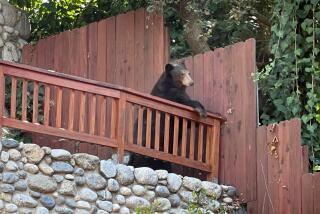Answer to Fires Is Old as the Hills
It’s deja vu all over again. The Coast is toast, again. The American West looks like the West Bank, again. Helicopters and lumbering air tankers circle overhead, armored vehicles prowl roads, uniformed crews stand guard. Thousands evacuate. Towns burn. A decade of celebrity fire seasons, beginning with the 1993 outbreak in Southern California, has left us short of names. Call these the Halloween fires.
There are plenty of reasons why fire thrives in the West. But there is no reason why these particular fires should be allowed to savage the countryside as they have. The burning of exurbs and suburbs is an especially dumb problem to have because technical solutions exist. We’ve known them for probably 10,000 years.
To understand the flames this time, you might reconfigure the famous “fire triangle” -- heat, fuel and oxygen -- this way: the houses, the landscape around them and those defending them. What especially matters is whether the structure can receive and return fire -- how readily it can ignite and how it might ignite buildings around it. (If you build a community out of forest materials, it will burn like a forest fire.)
Begin with the roofing. Combustible roofs collect sparks, and then give them out. The roofing is the point of greatest vulnerability. This has been known since forever. The “Aeneid” is a story that abounds with urban incendiary assaults that target roofs. Hook-and-ladder devices arose to climb onto roofs and pull off the thatch or wood shingles. After the 1923 fires in Oakland and Berkeley, California banned wooden roofs on new construction. It rescinded that prohibition during the postwar housing boom. The modern era of exurban fires followed.
Landscaping matters too. Fire has to reach a house. It can do so by direct contact, by radiant heat from a distance or by sparks caught in wind and convective swirls. Most fringe fires don’t consume structures in a tsunami of flame. The reality is more mundane. Each process requires distinctive countermeasures, variants of defensible space. It’s simple to stop direct contact: create a fuel break. A sidewalk or stone path will do nicely. Radiant heat demands more space. But its power drops quickly, which is why it’s hard to position yourself in exactly the right place near a campfire. Vegetation that produces less heat and that doesn’t cluster near the house is probably good enough.
Tougher to cope with are wind-blown sparks. Over short distances these can come as ember showers, which argues for greenbelts that can reduce high-intensity fires. Anything less than a mile will prove meaningless in the extreme events, in which they are most needed.
The operating concept is to create defensibility, not impregnability. An errant ember can be extinguished rapidly if someone is present to stomp it out. Few structures can withstand a direct hit from a high-intensity wildfire any more than they can take a direct hit from a tornado. But once a house and immediate surroundings become defensible, a firefighter can swat out sparks, douse trickles of encroaching flame, protect a structure -- and himself.
Such measures cannot guarantee the survival of every house. Some will perish because of local quirks, lapses, chance. But it is possible to shatter the chain of combustion. One burning house doesn’t lead to others.
That’s the core insight. The power of fire resides in its power to propagate. This is why arson is a red herring. The arsonist’s torch is only as formidable as the capacity of a landscape to carry flame. We need to encourage landscapes that prevent the fire we don’t want.
Our failure is how we live on the land. This is not just about California exceptionalism.
All over the country, Americans are recolonizing their once-rural landscapes with former urbanites, powered by urban expectations, urban economics, urban aesthetics. It’s everywhere, and its hazards vary.
In North Carolina, the sprawl slams into hurricanes and ice storms. In the Midwest, it finds floods and tornadoes. In much of the West, it confronts fire. This tide of settlement isn’t going away. Like land-starved slash-and-burn farmers clawing up hillsides, the houses will push further into the countryside. This new pastoralism, like strip malls, can be handled well or badly.
The American West does not have a fire problem. It has many fire problems. Fixing fire on the urban fringe does not tell us what to do with fire in wilderness. It doesn’t address cheat grass in the Great Basin. It doesn’t resolve the beetle-killed forests encrusting the Cordilleras like a scab. It doesn’t prescribe solutions to degraded pinyon-juniper woodlands. It doesn’t even say how to restore biotic health, however defined, to the out-of-whack ponderosa pine, the model for a century of fire malfeasance in the public lands.
Until the West’s drought breaks, there is no grace period to work through these metastasizing fire issues. National attention and resources will rightly focus on the intermixed fringe. What to do about fire on that vast national estate beyond will continue as discourse.
It’s useful to remember, however, that fire isn’t listening. It doesn’t feel our pain. It obeys its own logic of terrain, wind, drought, fuel. Until we recognize fire’s supreme indifference to anything we say and its complete submission to what we do, our conflagrating muddle will persist.
More to Read
Sign up for Essential California
The most important California stories and recommendations in your inbox every morning.
You may occasionally receive promotional content from the Los Angeles Times.










